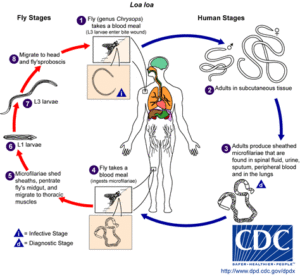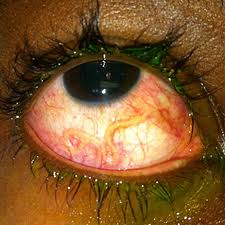Loa Loa
Loa loa is a blood dwelling nematode that is parasitic in humans and leads to the disease called Loiasis (also referred to as the African eye worm). In addition to the eye worm, the infection is most commonly associated with recurrent episodes of itchy swellings known as Calabar swellings.
Recognition of Loa loa infections has become more important in Africa because the presence of Loa loa infection has limited programs for the control or elimination of onchocerciasis and lymphatic filariasis. In Cameroon, Loa Loa is mainly prevalent in the South, East, Centre and Littoral regions of the country.
The disease is transmitted by deer flies which mainly bite during the day. If the deerfly feeds on infected blood, it takes in the parasite's larvae and when the deerfly breaks a human’s skin to eat blood, the larvae enter the wound and begin moving through the person’s body.
Larvae can only become adult worms in the human body and it takes about 5months from infection till the larvae becomes an adult. The adult worms live between layers of connective tissues under the skin and fertilised female worms can make about thousands of microfilariae per day.
These microfilariae move into the lymph vessels where they eventually move into the lungs where they spend most time. Adult worms live in the body for up to 17years and wander through the subcutaneous tissue but is most obvious as it crosses the conjunctiva of the eye hence leading to its common name, the African eye worm.
- The most common manifestations are eye worms which move on the surface of the eye and can cause eye congestion, itching, pain and light sensitivity. The visibility usually lasts for about a week.
- Calibre swellings which are localised, non-tender swellings which are usually found on the arms and legs.
- Itching can occur around the area of swelling or just all over the body.
- Adult worms can sometimes be seen moving under the skin.
- Kidney damage can occur due to years of infection.
This is one of the hardest infections to treat despite that, surgical removal of the eye worm is possible but that doesn't cure the infection as the parasite is often found in other parts of the body. This process helps to provide immediate relief. More so, the parasites might be killed by use of the drug DEC (Diethyl-carbamazine). The recommend dosage of DEC is 6 mg/kg/d taken three times daily for 12 days.


